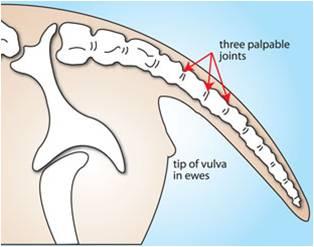Castration and tail docking
Castration should be performed on lambs as early as management practices will allow, preferably before 12 weeks of age. Pain relief should be used for castration and tail docking. Registered pain relief options are available in Tables 1 and 2.
Current methods of castration include:
- Rubber rings applied according to the manufacturer's recommendations.
- Cutting. The lambs should be properly restrained and the knife must be kept clean and sharp.
Tail docking of lambs is recommended for blowfly control under the Code of Practice for Sheep in Western Australia, 2003 (COP – Sheep). Acceptable methods of tail docking include: rubber rings applied according to the manufacturer’s recommendation, a gas flame-heated searing iron (‘gas knife’) used according to the manufacturer’s recommendations or cutting with a sharp knife.
The Department of Primary Industries and Regional Development (DPIRD) recommends that producers use rubber rings or a gas knife when tail docking. The gas knife method is generally preferable for tail docking on lambs that are also mulesed. If using a gas knife when the weather is windy, a wind block can be used to maintain the knife at optimum temperature. A knife that is too cold will not cut through the tail in one motion. A knife that is too hot will cut through the tail too quickly and not cauterise the tail tip and increase blood loss.
There are two types of gas knives available to producers in Australia, a standard knife and a rotating anvil knife (known as the Te Pari Patesco knife®). Both knives cause similar wounds and work in the same way; however a Te Pari knife has a rotating anvil which stretches the woolly skin prior to cutting. This leaves a greater bare area, where wool would normally grow and be at risk of urine stain and dags. For more information on the Te Pari knife please see the managing flystrike webpage.
Lambs should be docked to the third palpable joint or to the tip of the vulva in ewes and to the same length in wethers to reduce flystrike risk. Shorter tailed lambs have higher incidences of rectal prolapse and vulva cancer. Tail docking at a shorter length does not necessarily mean less flystrike.
Mulesing
It may not be necessary to mules sheep on properties that are in a low risk area and on properties where producers actively select and breed for fly and worm resistance. Animals that will be sold for slaughter prior to the high flystrike risk period do not need to be mulesed. Read more information on managing non mulesed sheep and reducing your risk of flystrike.
For producers who continue to mules, the procedure should be conducted in accordance with the COP – Sheep. A registered pain relief product should be used, and the procedure should be done by an accredited operator, to minimise trauma and to remove the minimal amount of wool-bearing skin adjacent to bare skin.
The following principles should be followed:
- Lambs should be mulesed two weeks after the end of lambing.
- If lambing extends for more than six weeks, consider having two mulesing/marking sessions.
- Maintain a high standard of hygiene and use sharp, clean equipment.
- Do not mules when conditions are ideal for flies.

